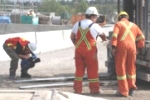
New Developments Boost Work Zone Safety
Several positive developments in highway work zone safety are taking place this year, highlighted by a federal rule on temporary traffic control devices (23 CFR 630 Subpart K) that takes effect Dec. 1. Connecticut's Gov. M. Jodi Rell signed a bill June 1 that could penalize drivers who seriously injure a work zone employee with fines up to $5,000 ($10,000 if the worker dies), and the ANSI A10.47 Work Zone Safety and Highway Construction rule may be finalized by the end of this year, Chairman Scott Schneider says. Last Friday, a 54-minute FHWA/ARTBA webinar explaining the Subpart K rule was posted (http://wzsafety.tamu.edu/node/8802) with an accompanying PowerPoint presentation about the new rule.
More than 40,000 people are hurt in work zone crashes per year, and almost three deaths per day occur in work zones on average, presenter Chung Eng of the National Work Zone Clearinghouse says in the webinar.
Subpart K applies to all state and local agencies that receive federal-aid highway funding. It was issued in response to Section 1110 of the current federal highway funding law, which directed DOT to enact regulations on the use of uniformed law enforcement officers, positive protective measures between workers and motorized traffic, and installation and maintenance of temporary traffic control devices during construction, utility, and maintenance operations on such projects, which will be requlred to have separate pay for major categories of traffic control devices, safety features, and work zone safety activities. While the rule does not require the use of law enforcement officers on projects, it does require the agency to develop a policy addressing their use and to consider situations where the use of uniformed law enforcement officers could improve the safety of road users and workers.
Connecticut's new law says someone who is driving in a work zone commits the offense "endangerment of a highway worker" when they exceed the posted speed limit by 15 miles per hour or more, fail to obey a traffic control device, drive through or around the zone in any lane not clearly designated for traffic, or physically assault, attempt to assault, or threaten to assault a highway worker with a motor vehicle or other instrument. The law creates a Highway Work Zone Safety Advisory Council to make ongoing recommendations to improve safety in these zones.
Schneider, OSH director of the Laborers' Health and Safety Fund of North America, said Friday that he hopes the A10.47 standard can be finalized by the end of 2008. The A10 committee, of which ASSE is the secretariat, is meeting today and tomorrow in Washington, D.C., but the standard is not yet ready for balloting to the full committee, Schneider said. The proposed standard includes procedures and precautions for traffic control, flagger safety, runover and backover protection, equipment operator safety, power tool safety, fall prevention, materials handling, illuminated night work, and PPE, he said.